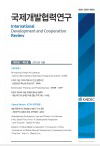학술논문
개발도상국 축산 부문 개발 정책 효과성 연구: 르완다 Girinka 프로그램을 중심으로
이용수 186
- 영문명
- Effects of a Livestock Development Policy: Girinka Program in Rwanda
- 발행기관
- 국제개발협력학회
- 저자명
- 최용욱(Yong-woog Cho) 김동훈(Donghoon Kim)
- 간행물 정보
- 『국제개발협력연구』제8권 제1호, 203~230쪽, 전체 28쪽
- 주제분류
- 사회과학 > 정책학
- 파일형태
- 발행일자
- 2016.04.30
6,160원
구매일시로부터 72시간 이내에 다운로드 가능합니다.
이 학술논문 정보는 (주)교보문고와 각 발행기관 사이에 저작물 이용 계약이 체결된 것으로, 교보문고를 통해 제공되고 있습니다.

국문 초록
본 연구진이 르완다의 Girinka(One Cow Per Poor Family) 프로그램에 주목하게 된주요한 계기는 이 프로그램이 잠재적으로 지니고 있는 정책 효과의 확산성 때문이었 다. Girinka 프로그램은 기본적으로 한 단위의 정책 대상에게 주어지는 정책 수단의 정책 목표가 성취될 경우, 그 다음 정책 대상자가 동일한 혜택을 최소한의 비용으로 받도록 구조화되어 있기 때문에, 이론적으로 정책 목표 달성을 위한 선순환 구조가 내재되어 있다.
정책 대상 농가가 축산 활동을 통해 기대할 수 있는 주요 편익으로는, 축산물 생산 으로 인한 편익을 들 수 있으며, 아울러 젖소의 분뇨를 활용한 비료를 투입함으로써 얻게 되는 작물 생산 증가분 편익을 들 수 있다. 축산물 생산을 위한 총비용으로는 축사건축비, 사료비, 물 구입비, 의료비 등을 대표변수로 산정하였다.
르완다의 1인당 GDP는 644달러이며, 4인 가족 기준으로 했을 때, 가구 당 GDP는 2,576달러가 된다. 한편 Girinka 프로그램이 예상대로 시행될 경우, 정책 시행 4년 차부터 추가적으로 발생시킬 것으로 예상하는 정책 수혜 1가구 당 경제적 편익 규모는 가구 당 GDP의 약 1.5배에 달할 것으로 보인다.
이와 같은 정책 효과의 재무적 가치 측정을 통해 정책의 가시적 성과의 예상 규모를 판단해 봄으로써, 정책성과 측정의 기준을 제시하고자 시도하였다.
Girinka 프로그램은 여러 제약요소에도 불구하고 일차적으로는 젖소의 사육을 통한 축산 수익과 배설물을 활용한 작물 생산량의 증대를 목표로 하며, 이차적으로는 정책 수단으로 지급된 젖소의 정책 효과가 다음 정책 대상자에게도 전해지도록 구조화함으 로써 정책의 수평적 확산을 지향하고 있다. 이와 같은 형태의 정책 효과는 장기적으로 정책 수혜자의 삶의 질 향상이라는 형태로 나타나게 된다. 즉 영양 섭취의 양과질 향상, 의료 접근성 향상, 교육에 대한 접근성 확대, 가용 생활 편의 시설 증가와 같은 유무형의 복지 증진 가능성은 Girinka 프로그램의 장기적 효과에 대한 기대감을 갖도록 해준다.
다만 프로그램의 효과를 저해하는 제약 요인에 대한 통제 및 긍정적 효과를 극대 화하는데 필요한 강화 요인에 대한 지원이 수반될 필요가 있다. 즉 전반적인 가축 의료 서비스의 개선, 축산 경영 관련 교육의 실시, 종축개량을 위한 인공수정 관련 교육 실시 및 전문가 양성, 지역적 환경에 적합한 사료 작물 육종 및 활용 기술 교육과 같은 부문에 대한 조사 대상자들의 지적은, 정책 수혜자들의 수요를 반영함과 동시에 정책적 제약 요인 통제 및 강화 요소의 투입을 위한 방향성을 보여준다고 하겠다.
영문 초록
One of the main reasons for our attention to Rwanda s Girinka (One Cow Per Poor Family) program was its potential for policy effect distribution among policy targets. That is, the structure of this program is such that if the policy goal for a unit of policy targets is achieved, the next policy target automatically receives the same policy benefits at minimum costs, so a virtuous circle is inherent throughout its policy processes.
The farm households that received milk cows can expect the following major benefits through livestock production: benefits from production of livestock products (meat, milk, etc.) and benefits from crop production increases due to input of fertilizers utilizing the cows excrements. Components of the total cost for livestock production include stable construction costs, feed expenses, water purchase costs, and medical expenses. Additionally, labor activity and time for livestock production (feed procurement, milking and so on) can be taken as opportunity costs even though they would not be direct expenditure on visible goods.
Rwanda s per capita GDP is 644 dollars. On a basis of 4-person households, GDP per household amount to 2,576 dollars. If the Girinka program produces the result similar to the outcome that this research assumed, the average benefit per policy beneficiary household for the first 3 years after policy implementation would be 1,913.2 dollars, and that after the third year is 3,748 dollars, 1.96 times the previous figure. That is, the benefit per beneficiary household for the first 3 years after policy implementation is 74% of GDP per household, and the additional benefit, about 1.5 times GDP per household, occurs from the fourth year and on.
We can judge the size of the policy s visible performance by measuring the policy effects financial value. In the meantime, some of the benefits will be consumed, while some will be accumulated as assets. The benefits additionally consumed can improve policy targets nutritional status and capability. The accumulated assets can be reinvested as the production base for creating more profits, which in turn can enhance social dynamism. The assets can also be the insurance that provides funds when urgently needed.
The Rwanda economy s recent economic performance seems to partly reflect the collective outcome of national policies including the Girinka program. This study tried to present a standard for measuring the performance. If several assumptions and forecasts in the process are rechecked and become more accurate through accumulation of time and more experimental surveys, it will be able to more contribute to improving the program to a more effective and sustainable livestock development policy and, in the end, designing new policies too. Also, if comparative studies with other countries similar policies and other livestock policies are conducted in the future, a more generalized understanding of livestock development policy will be possible.
목차
Ⅰ. 서 론
Ⅱ. 연구방법
III. 연구결과
IV. 결 론
키워드
해당간행물 수록 논문
- 성인대상 이러닝 기반 국제개발이해교육의 인지적 ․ 태도적 학습효과성에 대한 실증적 연구: S사이버대학 재학생을 중심으로
- Visible Government, Invisible People: Unpacking Participation in Korean Aid Agency’s Development Projects
- 사하라이남지역에서 부채탕감(HIPC Initiative)이 투자에 미친 영향
- 개발도상국 e-러닝 학습자의 태도에 관한 Q유형 분석
- Labour Migration and Migrants in Urban Ghana
- 개발협력에서 지속가능한 출구전략의 수립과 운영에 대한 연구
- 개발도상국 축산 부문 개발 정책 효과성 연구: 르완다 Girinka 프로그램을 중심으로
참고문헌
교보eBook 첫 방문을 환영 합니다!

신규가입 혜택 지급이 완료 되었습니다.
바로 사용 가능한 교보e캐시 1,000원 (유효기간 7일)
지금 바로 교보eBook의 다양한 콘텐츠를 이용해 보세요!





